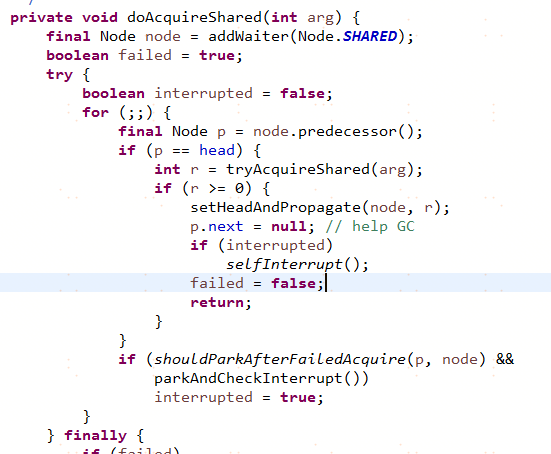一 共享锁和排他锁的不同
排他锁中state的含义是初始值0,每次重入就加1,释放就减1,完全释放完必须是0
共享锁state初始值是大于0的正数,表示可共享的数量,获取一次就减1,减到0则不能再获取
二 共享锁的入口
public final void acquireShared(int arg) { if (tryAcquireShared(arg) < 0) doAcquireShared(arg); }
需要用户去实现的方法就是 tryAcquireShared ,该方法在jdk中的注释如下
* @return a negative value on failure; zero if acquisition in shared * mode succeeded but no subsequent shared-mode acquire can * succeed; and a positive value if acquisition in shared * mode succeeded and subsequent shared-mode acquires might * also succeed, in which case a subsequent waiting thread * must check availability. (Support for three different * return values enables this method to be used in contexts * where acquires only sometimes act exclusively.) Upon * success, this object has been acquired.
当失败的时候返回的是负值,如果返回的是0表示获取共享模式成功但是它下一个节点的共享模式无法获取成功。如果返回的是正数也就是大于0,表示当前线程获取共享模式成功,并且它后面的线程也可以获取共享模式。
当获取失败就会进入doAcquireShared
private void doAcquireShared(int arg) { final Node node = addWaiter(Node.SHARED); boolean failed = true; try { boolean interrupted = false; for (;;) { final Node p = node.predecessor(); if (p == head) { int r = tryAcquireShared(arg); if (r >= 0) { setHeadAndPropagate(node, r); p.next = null; // help GC if (interrupted) selfInterrupt(); failed = false; return; } } if (shouldParkAfterFailedAcquire(p, node) && parkAndCheckInterrupt()) interrupted = true; } } finally { if (failed) cancelAcquire(node); } }
我们可以对比下排他锁的代码


看得出来,唯一的区别就是 setHeadAndPropagate,道理也好理解,排他锁每次只能一个线程获得锁,获得后方法return,只需要等着客户端调用unlock唤醒后续的线程。
但是共享锁每次获得锁的不止一个线程,当一个线程获得锁后,如果state>=0,则需要继续唤醒后续等待中的节点
下面重点分析下
private void setHeadAndPropagate(Node node, int propagate) { Node h = head; // Record old head for check below setHead(node); /* * Try to signal next queued node if: * Propagation was indicated by caller, * or was recorded (as h.waitStatus either before * or after setHead) by a previous operation * (note: this uses sign-check of waitStatus because * PROPAGATE status may transition to SIGNAL.) * and * The next node is waiting in shared mode, * or we don't know, because it appears null * * The conservatism in both of these checks may cause * unnecessary wake-ups, but only when there are multiple * racing acquires/releases, so most need signals now or soon * anyway. */
// h.waitStatus < 0 当一个
//h == null ||
if (propagate > 0 || h == null || h.waitStatus < 0 || (h = head) == null || h.waitStatus < 0) {//propagate>0 表示共享锁本次释放出来的不只是一个,所以可以继续唤醒。至于 Node s = node.next; if (s == null || s.isShared())//s==null那不就是队列里没有节点了?因为只有tail的next才是null的,现在是head==tail了 doReleaseShared(); } }
关于waitStatus,一个Node刚new出来的时候是0,如果它后面有node继续,会把它的前驱置为signal = -1,如果调用了doReleaseShared,会把头节点置为PROPAGATE= -3.
h.waitStatus < 0
上面的代码的意思,在本线程称为header的时候,可能有另一个线程执行了releaseShared,这样头结点的waitStatus可能会被设置为PROPAGATE,正因为有可能是这种情况,那么既然别的线程
release了,那么现在执行一次唤醒也是合理的,只不过不能保证本次唤醒一定能让等待的线程获得锁。代码注释中也说了
may cause unnecessary wake-ups
二 释放锁
public final boolean releaseShared(int arg) { if (tryReleaseShared(arg)) { doReleaseShared(); return true; } return false; }
tryReleaseShared 是有子类去实现的,重点看看 doReleaseShared
private void doReleaseShared() { /* * Ensure that a release propagates, even if there are other * in-progress acquires/releases. This proceeds in the usual * way of trying to unparkSuccessor of head if it needs * signal. But if it does not, status is set to PROPAGATE to * ensure that upon release, propagation continues. * Additionally, we must loop in case a new node is added * while we are doing this. Also, unlike other uses of * unparkSuccessor, we need to know if CAS to reset status * fails, if so rechecking. */ for (;;) { Node h = head; if (h != null && h != tail) { int ws = h.waitStatus; if (ws == Node.SIGNAL) { if (!compareAndSetWaitStatus(h, Node.SIGNAL, 0)) continue; // loop to recheck cases unparkSuccessor(h); } else if (ws == 0 && !compareAndSetWaitStatus(h, 0, Node.PROPAGATE)) continue; // loop on failed CAS } if (h == head) // loop if head changed 这里不难理解 head变了当然要再次唤醒,唤醒本身不会有啥严重后果,最多就是被唤醒的线程拿不到锁再阻塞 break; } }
else if (ws == 0 && !compareAndSetWaitStatus(h, 0, Node.PROPAGATE))
这段该怎么理解呢?只有一个节点新加入队列或者 在唤醒后续之后,才会被设置成0。如果是0这里就把他设置为PROPAGATE=-3,同时continue,让自旋再次执行
如果在本次循环head不变那就退出循环。
对比排他锁的释放,共享锁这里有两点
1 释放头节点的后继,通过CAS把signal变成0
2 如果走到第二个分支,把0 CAS成 -3 。
这是因为共享锁锁不止一个,所以可能会在不必要的时候释放,这样SIGNAL会变成0,但是也不用担心,被唤醒的线程竞争不到还是会在把自己阻塞前把它的前驱再次置为SIGNAL的
PROPAGATE 我搜索代码发现设置PROPAGATE地方只有这个 doReleaseShared ,把0变成-3
然后搜索 waitStatus < 0
也只有
private void setHeadAndPropagate(Node node, int propagate) { Node h = head; // Record old head for check below setHead(node); if (propagate > 0 || h == null || h.waitStatus < 0 || (h = head) == null || h.waitStatus < 0) { Node s = node.next; if (s == null || s.isShared()) doReleaseShared(); } }
我这里说一下 PROPAGATE的意义
一个线程刚好获取到锁,那么他会执行 setHeadAndPropagate ,设置了新的head后,
假设刚好有两个线程都在执行releaseShared
那么第一个线程会执行
if (ws == Node.SIGNAL) { if (!compareAndSetWaitStatus(h, Node.SIGNAL, 0)) continue; // loop to recheck cases unparkSuccessor(h); }
因为只有一个线程会CAS成功,所以当第二个线程也执行这段代码
就只会走else分支
else if (ws == 0 &&!compareAndSetWaitStatus(h, 0, Node.PROPAGATE)) continue;
再把0变成-3,continue 自旋继续,如果刚才被释放的线程没有执行到抢锁,也就是说head没变,那么两个线程执行了release方法后,线程就结束了。
这时候继续在 setHeadAndPropagate 执行
就会发现 h.waitStatus < 0 就满足了,那么由于两个线程释放锁,说明有可能至少还有一个资源,就应该再执行一次释放流程
另外还需注意一点,共享锁的释放是一个自旋操作,因为可能不止会释放一次。每次都要判断新的head和旧的head是不是一样的,如果不一样了那就继续释放。
要理解共享锁,还有一个小心得。排他锁当一个线程拿到锁后,旧的head其实就退出了临界区。但是共享锁不一样,后一个线程拿到锁把自己set成了head,但是其实原来的head线程还没有跑完自己的代码。
说一下enq方法
一个小小的enq方法也有值得研究的地方
private Node enq(final Node node) { for (;;) { Node t = tail; if (t == null) { // Must initialize if (compareAndSetHead(new Node())) tail = head; } else { node.prev = t;//注意先设置pre if (compareAndSetTail(t, node)) {//tail通过CAS,如果不成功,自旋后还会再次设置pre,这样才能保证正确性 t.next = node; return t; } } } }